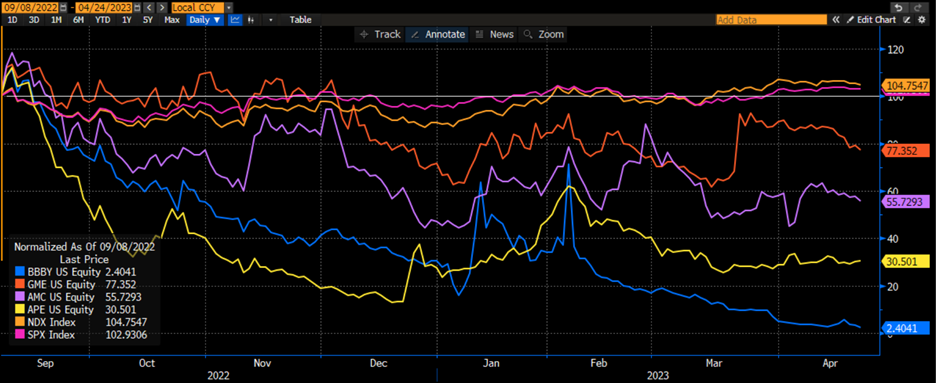Bed, Bath And The Great Beyond

Image Source: Pixabay
By: Steve Sosnick Chief Strategist
Punny headline aside, I have no joy in writing today’s piece. It’s never pleasant when a company goes bankrupt, especially one that I have patronized over the years. We’ll leave it to others to analyze the multitude of factors that caused the demise of Bed, Bath and Beyond (BBBY); this piece will be about the mass delusion that prolonged and preceded it.
By this point, I assume that every reader is familiar with the term “meme stock” and the frenzy that spawned the name. In early 2021 we saw a remarkable frenzy of buying in a cadre of stocks. GameStop (GME) was of course the poster child, but other names like AMC and BBBY had similar surges. The pandemic brought work-from-home, stimulus checks, and a greater role for social media in investing than ever before. When some clever investors noticed that there were abnormally large short positions in these names, it brought about a short squeeze that quickly morphed into a mania.
The concept of a short squeeze is nothing new. There have probably been short squeezes for as long as there have been shorts. Short sellers are speculating that a company’s share price will deteriorate. It is an inherently risky game. For starters, their profits are limited – a stock can only fall to zero – while their upside is not. Also, they need to borrow the shares that they are selling. That exposes them to the risk that their borrowings can become prohibitively expensive. This can force the shorts to cover, causing prices to rise. Short squeezes can cause sharp rises in heavily shorted stocks, none more extreme than what we saw in early 2021.
At the time, we all struggled to wonder why there was such enthusiasm, if not an almost evangelical fervor, for a seemingly unrelated names whose only commonality appeared to be that a consistent lack of profitability enticed short sellers. I relied on a definition provided by my then-23-year-old son, who texted me the following observation:
“The short squeezed WSB stocks all have one thing in common besides being short squeezed. They’re all things a 20-something person would be nostalgic for. GameStop, AMC, Nokia, Build-a-Bear – things that would make you sad to hear are failing business because it means that you’re old.”
There was an emotional chord behind the mania, beyond even the desire to get rich and the latest expression of the age-old desire to “stick it to the man”. There is a real sense of advocacy behind many of the posts, and this would explain it. Beyond the names mentioned in Charlie’s text are other popular “old-school” brands like Express, Koss, Bed Bath & Beyond and Tootsie Roll. All household names, all places that they went to as children or brands that they asked for on those shopping trips. I certainly can’t verify this being the only cause of the recent mania – it was undoubtedly made combustible by short covering – but it seems like a reasonable explanation for the type of names that were chosen.
As crazy as that period was, I actually have an easier time understanding it than the persistence of the investors’ faith, particularly once it became apparent that some of these companies were abusing it.
Once AMC ran out of common shares that it could issue to investors, it created a new class of common-like preferred shares (APE) that it could issue instead. In a last-ditch effort to stave off bankruptcy, BBBY attempted a private offering of a similar class of stock that could be immediately converted into common stock and sold into the marketplace. I find it mystifying that there have been willing buyers of these stocks in the face of overwhelming evidence that these companies are using faithful investors as a financial lifeline.
But I’ve had my run-ins with the faithful before, especially when I’ve done my best to warn them about their folly. A particularly nasty run-in occurred in September. During a media appearance, I suggested these stocks were overvalued until or unless their fundamentals became positive. The host and I joked that I was exposing myself to a blowback on social media, and the faithful did not disappoint. Until now, I’ve refrained from commenting. The following graph shows the performance of key meme stocks and indices normalized to the date of those media comments:
Performances Normalized to September 8th, 2022, Nasdaq 100 (NDX, orange), S&P 500 (SPX, magenta), GME (orange), AMC (lilac), APE (yellow), BBBY (blue)
(Click on image to enlarge)

Source: Bloomberg
Since then, we see SPX and NDX with modest gains, having recovered fully from their autumn swoons. Of the memes, GME is the clear “winner”, having lost less than a quarter of its value. In fairness, their fundamentals appear to be improving after posting a profit last quarter. AMC has lost about half its value and APE about 70%. BBBY has of course lost nearly all. Schadenfreude would be tempting, but I take no pleasure in the misfortunes of people who gleefully mocked me on social media for pointing out the obvious. I simply wish they’d listened.
More By This Author:
Tesla Beats On A Key Metric/What Expiration?
What Is The Options Market Expecting For Tesla Earnings?
T-Bills Are Handicapping Banks And The Debt Ceiling Debate
Disclosure: The analysis in this material is provided for information only and is not and should not be construed as an offer to sell or the solicitation of an offer to buy any security. To the ...
more


